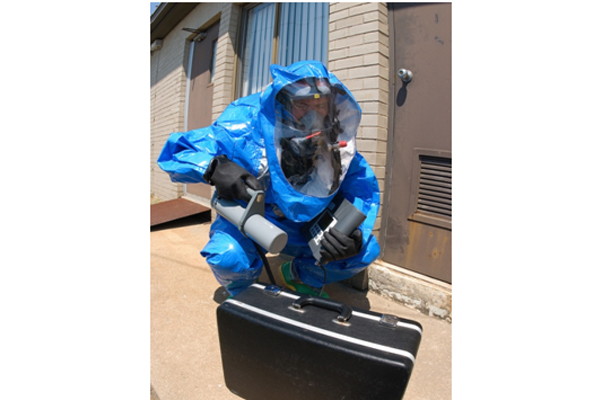|
The DuPont 9-step Guide to Chemical Risk Assessment
Performing a thorough workplace risk assessment is essential to selecting safe, comfortable and compliant chemical protective clothing for industrial workers. To help facilitate your garment selection, DuPont proposes using a step-by-step guide to risk factors, as part of the risk assessment process.
Step 1: Hazard identification
What is the chemical hazard? Is it gas, liquid, vapour or particle? Can the hazard change state (e.g from liquid to vapour)? What are the levels of concentration, humidity and temperature? Are there any additional hazards, such as heat, flame, explosion, radiation, electrostatic, biological substances, or sharp or abrasive surfaces? Are there special requirements for visibility or mobility?
Step 2: Determine minimum levels of protection needed
Certification to a Category III Chemical Protective Clothing type describes the tightness of the overall whole suit against a particular form of exposure (gas, liquid or dust). However, it certainly does not mean that the suit is 100% impervious to this type of exposure. Having a look at the detailed results allows the user to take conclusions on the actual barrier and impermeability of the suit.
Step 3: Assess hazard toxicity
Knowing the toxicity or consequences of short or long-term exposure to the hazard is essential. Assess whether a suit that just passes a certain type is sufficient protection. For example, a suit designed to have higher exposure type performance, such as a type 3 or 4, will offer a much lower amount of particle inward leakage, particularly if additional taping is used and will be a significantly better barrier than certain type 5 suits that in some cases it may just meet the standard.
Step 4: Determine protective performance requirements of the fabric & seam
Consider that liquid chemical penetration tests are conducted over a time period of just 60 seconds. In order to assess whether a fabric protects the wearer for exposure exceeding 60 seconds, the permeation data must be consulted. Permeation is the process by which a chemical, in the form of a liquid, vapour or gas, moves through protective clothing material on a molecular level (through the pores). Permeation can occur without visible traces. The test duration is 8 hours. Tip: refer to the DuPont permeation guide for a detailed explanation, examples and permeation data.
Having determined the performance level of the fabric, double check and ensure the seams have been tested and demonstrated to offer the same level of barrier.
Step 5: Determine mechanical performance requirements
The mechanical performance classes of the fabric and seam are an indication and, depending on the nature of the work, some properties may be more relevant than others. An excellent barrier is only worthwhile if it withstands working conditions and remains intact for the duration of the task. In addition, selecting the right size (e.g. by putting a selection of sizes at the wearer’s disposition) is essential to ensure proper protection. Avoid oversized or undersized suits, and ensure correct sizes are available.
Step 6: Comfort considerations
Protection is important, and so is comfort. Identifying the appropriate protective and mechanical performance, while also maximising wearer comfort can contribute to correct coverall use, thus optimising wearer satisfaction and productivity. Key comfort factors frequently cited in wearer trials include ample freedom of movement when bending/stretching, weight, feel on the skin, and breathability of the garment. Garments with both air and vapour permeability will be more comfortable, although these will also offer a lower particulate or chemical barrier than fully impermeable non-breathable materials.
Step 7: Supplier selection
Protection, performance in use, and comfort are key criteria, as is a manufacturer’s brand reputation for consistent quality. DuPont is ISO 9001 and ISO 14001 certified, and our protective coveralls and fabrics are manufactured with rigorous statistical quality controls that go well beyond the minimum requirements.
Step 8: Identify the correct usage of the product
Be aware of product limitations, as these can be a useful source of information on the correct use of the product. They may also raise important questions, such as whether additional taping is required, whether grounding requirements should be considered, performance when exposed to temperatures and whether a doffing procedure is required that necessitates training to avoid contamination.
Step 9: Wear test
Once you’ve made your selection, why not put the coverall to the test and evaluate its performance in use? Putting a product to the test via wear trials is a wise step in the selection process. DuPont offers a user wear trial program – try it!
Additional steps: customised assessment and testing services
DuPont offers a range of support tools to assist with the risk assessment and garment selection ranging from web-based tools and on-site risk assessment support with DuPont Personal Protection specialists and chemists, to chemical permeation barrier testing for your specific chemicals. DuPont specialists are also available to offer wearer training for safe use and product performance explanations to promote wearer acceptance. The Techline is available to answer technical questions. Our team of technicians manages a complex comprehensive database on physical properties, chemical permeation and penetration data on the materials used in Tyvek® and Tychem® coveralls.
|



